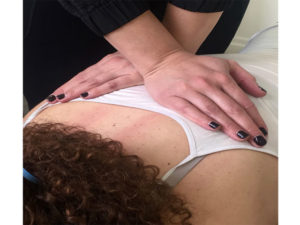UNDERSTANDING PAIN AND HOW TO DEAL WITH IT.
As posted to the Canadian Jewish News:
By: Dr. Deborah Mechanic
March 1, 2018
Most people are surprised to learn that 100 per cent of pain comes from the brain, not from injured body parts themselves. If that’s the case, why do we have pain?
Pain is about survival. Pain is meant to give us a biological advantage. It protects us by making us aware that something is wrong and allowing us a conscious opportunity to fix the problem.

It may be an ache in your thighs after a tough workout or soreness in your neck when you wake up, but pain is not actually coming from your thigh or neck. Current research demonstrates that body tissues themselves don’t actually have the ability to create pain at all. Rather, nerve endings within the tissues (called nociceptors) send a signal up the spinal cord and to the brain for a response.
The brain has two functions when it comes to pain: to evaluate sensations coming into the body and to determine an action to rectify the situation. Nerves are constantly assessing what we’re feeling and how the world around us is affecting our body. In the case of injury, nerves tell the brain that something is wrong and the brain has to process that information. Pain is the brain’s way of ensuring an immediate response to the signal by saying “I really don’t want this to continue, so I’m going to make it very uncomfortable.”
The brain reacts in an unpleasant way, giving us a chance to correct the problem. It’s an important reaction in cases where something dangerous may be happening. For example, if you were to put your hand on a hot stove, the extreme heat against your skin sends a signal alerting the brain that something isn’t right. This is where pain is an important advantage. In order to remove the threat, the brain produces pain as an alarm that we can recognize and address – in this case, removing your hand from the heat.
Immediately after an injury, you’ve probably experienced swelling and increased pain. This immediate stage is known as acute pain, which can last up to 72 hours after the injury. Swelling adds pressure to the nerves at the site of injury and furthers the signal to the brain that brings on pain. Interestingly, pressing on the site of pain with your fingers has been known to decrease pain. This is because the path that carries the signal from the injury to the brain is the same path that carries the pressure from your fingers. The pressure gets there faster than the pain response can be generated, cancelling it out temporarily.
Once an injury has passed the 72-hour mark, the early damage-control response slows and healing kicks in. This is the subacute stage of pain. In most injuries, healing will be nearly complete at three months. After the three-month healing stage, if there is continued pain, it’s classified as chronic pain and typically no longer comes from the original injured tissue.
So what’s the best way to handle pain?
Muscles tighten around the damaged area and nearby joints will stiffen to prevent any extra movement, protecting from further injury. As injuries progress through the stages, pain typically lessens and the muscles and joints will release. This is where a hands-on approach is especially helpful.
Seeking care for pain and injuries from a chiropractor or physiotherapist is a great way to help tight muscles and stiff joints return to their normal function.
An important part of treating any stage of pain is teaching tissues to let go. Calming the tissues in the area and assisting them to release can improve healing, decrease the amount of time spent in pain and decrease pain intensity. When seeking hands-on treatment for pain, the practitioner is usually able to examine the source of your pain, whether it’s a rolled ankle or waking up with a stiff neck, and give you the best methods to return to normal function, the fastest and safest way possible.
